Free Step by Step Drawings for Outdoor Deck
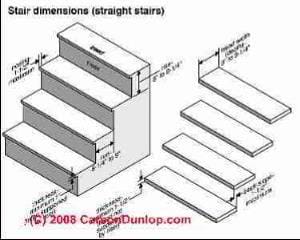 Stair step height: Guide to Stair Riser Dimensions
Stair step height: Guide to Stair Riser Dimensions
- POST a QUESTION or COMMENT about stair and step riser heights and dimensions and building codes
InspectAPedia tolerates no conflicts of interest. We have no relationship with advertisers, products, or services discussed at this website.
Stair riser specifications:
This article provides building code specifications, sketches, photographs, and examples of the proper stair step height or stair riser dimensions and other stair riser requirements for indoor or outdoor stairways. We compare the code requirements for closed riser and open riser stairs and we include other basic stair tread and riser dimensions.
Topics here include Allowable variation in stair step riser height by code & to avoid tripping. Definition of & specifications for open riser & closed riser stairs. Suggestions for adapting pre-fabricated stairways to the to the actual overall stairway height without violating building stair codes & standards.
Basic stair riser height dimensions required for safe stairs. Different dimensions for open versus closed riser stairways. Stair safety hazards, photos of defects & Sketches of stair design requirements. Stair calculations: how to calculate custom stair tread & risers based on stair rise & run measurements.
We also discuss the allowable variation in stair or step riser height between individual steps in a stairway. Sketch at page top courtesy Carson Dunlop Associates.
We also provide an ARTICLE INDEX for this topic, or you can try the page top or bottom SEARCH BOX as a quick way to find information you need.
Stair Riser Dimensions, Specifications, Codes, Standards & Defects
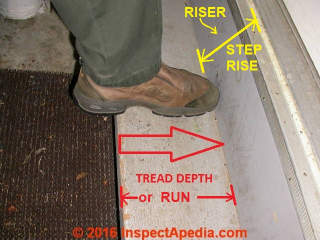
Stair risers are detailed here.
Because more people are injured by trips and falls than other hazards, experts have looked closely at the specifications for stairs, steps, and rails to reduce the falling hazards.
This work has been translated into stair and railing specifications that are similar among codes and countries (but not identical). -- IBC, IRC, BOCA, Kingston NY Stair Code, & other sources.
Definition of stair risers (stair riser height)
A stair riser (marked in yellow in our photo) is the vertical distance between the walking surface of two stair treads (treads are what you step on) - also referred to as the stair riser or riser height.
Stair riser height measurement- The riser height shall be measured vertically between the leading edges of adjacent treads.
- Maximum stair step riser height - not more than 7.75" or in some codes <= 7.0" or in Canada <=8.25"
- Minimum stair step riser height: - not less than 4"
- Step riser height uniformity - no more than 3/8" variation between successive step surfaces, or in some codes <= 3/16" / 4.8 mm.
Some codes such as the Virginia stair code permit greater variations in step riser heights provided that the individual steps that are at an off-riser height from their neighbors are marked with a special stripe that identifies the odd tread AND that is a marking different from strips or markings that may be required to indicate the outer edge of the tread or tread nose.
- Step riser slope (out of vertical) (<= 30 deg measured from horizontal surface of the tread).
This measurement describes step risers that may be set at an angle other than 90 degree vertical.
Risers shall be vertical or sloped from the underside of the leading edge of the tread above at an angle not more than 30 (0.51 rad) degrees from the vertical.
Don't confuse step riser height (defined above) with stairway headroom - the vertical space between the walking surface of a stair tread and the ceiling or other obstruction overhead
Headroom is defined further at STAIR HEADROOM.
The stair tread or run is the horizontal walking surface (red arrow in our photo above) of an individual step. It should be no less than 10". (IRC)
The stair tread depth, also referred to as the step "run" or horizontal distance in the direction of travel, is measured from the forward edge of the step nose or edge of the step above out to the leading edge of the step being measured - the space beneath my foot in the photo shown above.
Definition of Closed Riser Stairs
 Closed riser stairs (demonstrated at left by the author's granddaughter Quinn Morgan Gilligan) include a vertical riser board that enclose the space between the stair treads ) or walking surfaces.
Closed riser stairs (demonstrated at left by the author's granddaughter Quinn Morgan Gilligan) include a vertical riser board that enclose the space between the stair treads ) or walking surfaces.
In the photo our yellow arrow points to the step riser and the white arrow points to the stair tread.
The photo includes an unsafe bottom stair riser that is significantly different in height than the rest of the risers in that entry.
If the vertical space is enclosed (see our Carson Dunlop sketch at the top of this page), the enclosing board is called the stair riser.
The trip and fall hazard caused by stairs whose steps are uneven in height (rise) has been known probably for thousands of years as one discovers it promptly when using uneven-rise stairs without paying close attention to the step height.
While most false-step stair hazards are constructed in error, in some structures stair builders deliberately created a so-called false-step as a security measure against intruders.
See FALSE STEP STAIRS found
in SLIP TRIP & FALL HAZARD LIST, STAIRS for details
Summary of Ideal Stair Dimensions for Closed Riser Stairs
 This beautiful stairway is in the old central Post Office building in Mexico City.
This beautiful stairway is in the old central Post Office building in Mexico City.
The marble stair treads are a bit slippery and there is no handrailing along the lower rounded steps, but the tread dimensions are correct and comfortable.
Closed riser stairs include a board or other solid material that encloses the vertical space between stair treads.
- Stair riser height: ideal: 7 3/4
Some older homes include a very steep stairway to access the home's attic.
The stairs were very tall or "steep" when there was simply not enough horizontal space for a longer and less steep stairway. It may be impractical to fix this condition by a new stairway for the same reason - there just isn't enough space.
Be sure to reduce the falling hazard at steep stairs by providing good lighting and secure handrails.
See ATTIC STAIR CODES & HAZARDS
- Stair tread nosing: required, 1" to 1 1/2" projection beyond the riser face
- Stair tread run (or horizontal depth): 8 1/4 to 9" or no less than 10" per the U.S. IRC.
- Stair tread thickness: 1" or greater, tread is supported by the riser.
Details are at STAIR TREAD DIMENSIONS
Definition of Open Riser Stairs
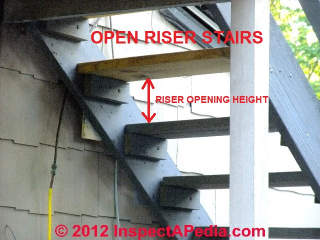 If the vertical space between stair treads is open (see our photo at left) the space is still a stair riser, but it's an "open riser".
If the vertical space between stair treads is open (see our photo at left) the space is still a stair riser, but it's an "open riser".
Or simply put, open riser stairs have no enclosure (my toe, shown above would be facing into open space).
Open stair risers with a more than 4-inch opening are a child hazard, as we detail below.
Summarizing proper stair dimensions for Open Riser Stairs
Open riser stairs (shown at right in the sketch above) do not include a solid board or other material that fully encloses the open space between stair treads.
Step stair riser openings: open stair risers are permitted provided the opening will not pass a 4" sphere (child safety). This 4-inch opening dimension has the same basis as the rule that requires that the opening between stair balusters must be 4" or smaller.
- Open riser stair treads should be to 9 1/4" in depth and will typically be greater at shorter stair riser heights.
- Open riser stair treads must be at least 1 1/2" thick because the tread, not supported by a riser, may otherwise split.
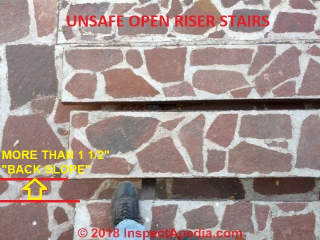
Photo above: notice that these stairs are built with an excessive "back slope" - there is more than 1 1/2" opening between the back edge of the lower stair tread (under my foot) and the leading edge of the upper tread.
- Maximum back slope on open riser stairs: Open riser stairs are allowed a back slope of at most 1 1/2.
If stair treads are constructed so that the front edge of a tread is more than 1 1/2" behind the back edge of the stair tread below, the treads can become a trip hazard.
Take a look at the sketch of stair specifications at the top of this page.
Because there is no solid vertical riser to enclose the space between stair treads, the concept of a stair tread "nose" does not apply.
Too-Short-Run Under-Sized Treads Cause of Unsafe Open Riser Stairs
Watch out: As my foot illustrated in the photo below, we often find open riser stairs that are unsafe because the tread inner edge does not extend beneath the outer edge of the tread above - excessive stair step or tread riser "back slope" as we defined it above.

Where there are several inches of open space at the inside edge of a stair tread someone, particularly a child with small feet, could easily step into this space, risking serious injury.
These stair treads, at a restaurant in San Miguel de Allende, Guanajuato, Mexico, are also too short in depth, less than 10" and so are under-sized.
If the builder had simply made each stair tread 2" greater in depth or run, both of these stair fall hazards would have been avoided.

Someone may have fallen into these stairs because several years after I took the photo above I found that the property owners had added a filler across the open space at the inside edge of the stair treads.
Are These Stairs Open Riser or Closed Riser Design?
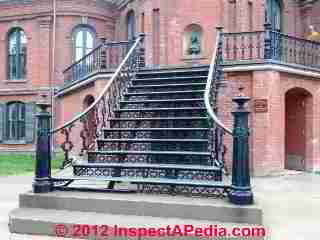
The lovely stairway shown at left rises to the main entry for the Maria Mitchell Observatory on the Vassar College Campus, Poughkeepsie, New York.
But are these open risers or closed riser stairs?
These are closed riser stairs (except for that broken missing riser at the first step) because the cast iron grid work defines the limits of placement of the leading toe of a foot of someone ascending these steps.
Therefore the rules for stair nose design and projection apply to these steps.
Stair Riser Defects in Height, Slope, Consistency
 I'm not sure what to say about this remarkable stairway found in Oxaca.
I'm not sure what to say about this remarkable stairway found in Oxaca.
Perhaps at night or in dim light, someone walking near the center of these steps is going to go sailing. Reader comments are invited.
Quick Summary of Stair Riser or Height Hazards
As we explained above, the most common stair riser defects likely to lead to a fall include:
- Stair risers of uneven height between various steps in the stairway. This means that there should be no step to step walking surface height variation greater than 0.375 inches
- Stair risers of improper height, too tall - as we cite above the definition of steps that are "too tall" varies by jurisdiction but 7" is a good design number in the U.S. , or 8" max in Canada.
Stair risers, or the vertical distance between the stair treads, that are too tall are difficult to climb and are a falling or trip hazard.
- Stair risers of improper height, too short - under 4" in step height.
Stair risers that are too short can also be a trip hazard if the stair treads themselves (the walking surface of the stair or step) are not large enough. As we discuss below, generally as we reduce the stair riser height below about 6-inches, we need to increase the "depth" (front to back distance) of the stair tread.
What happens if you make any step riser less than 4" is that walkers tend to trip over the mini-step as an obstruction rather than recognizing it as a step up.
While we never recommend building a known trip hazard, if a an existing walkway cannot avoid step risers less than 4" high, because it is a trip hazard (and probably a code violation in most jurisdictions) you can at least reduce the risk by using clear color changes to give a visual clue marking the changes in height.
See COLOR / LIGHTING CUES AVOID TRIP HAZARDS
- Stair risers that are uneven or irregular in height are also a serious trip and fall hazard.
That's because when people walk up and down stairs we are mostly on "auto pilot" - our brains assume that each step height will be the same as the one we took just before.
So a "surprise" such as a step that is taller or shorter, can make us fall - a particular hazard for the elderly, children, or people who are physically disabled and have trouble climbing stairs.
Also see ELDERLY & VETERANS HOME SAFETY.
These Deck Stairs Combine Nearly Every Stair Mistake
 Nothing is right about the exterior stairs shown in our photo (at left ) from a 1991 home inspection:
Nothing is right about the exterior stairs shown in our photo (at left ) from a 1991 home inspection:
- This stair stringer is too-deeply notched and could split;
- The open stair risers are too high, as our client is showing with our tape.
- The step rise is not consistent from top to bottom, with a taller rise at the bottom step
- The stair treads are too narrow - short depth or too-short stair tread "run"
- There is no stair guard rail and
- There is no hand railing at all along these stairs (and the height above ground is more than 36" which means that in just about every jurisdiction stair railings would be required by the building code)
- The deck and platform railing is open with no balusters.
- The stair treads are installed "upside down" with the cupped side up so that the treads retain water, encourage algae growth, and in freezing climates, encourage ice formation
- The stair stringers are poorly-secured to the deck rim joist, risking stair collapse
- There is no landing platform that might have corrected for the extra rise at that bottom step.
About the only stair mistake missing from these wonderful deck "stairs" we found at a home inspection is the error of excessive back-slope of the open risers.
See DECK STAIR BUILDING START for more details.
Reader Q&A - also see the FAQs series linked-to below
 @Carolyn Wagstaff,
@Carolyn Wagstaff,
Thank you for a helpful question about building codes and stair codes and tall step riser height in Mexico.
I don't know what local officials in Algodones (Vicente Guerrero) Mexico have to say about step height, but in general, even where there are building codes they're not usually enforced to the level of detail of stair design.
In Guanajuato my experience is that a principal concern of building officials is to assure that owners don't build above a permitted height nor violate other more-general guidelines such as intruding on neighbors privacy.
[Click to enlarge any image]
I've been and documenting steps and stairs and their handrails and guardrails in Mexico since 1960, so I appreciate that you're quite right that there are plenty of tall risers and other step details throughout the country that can be a trip hazard.
"93% of Mexico's municipalities have no construction regulations, ... They're not much more than administrative formalities anyway, says disaster prevention official" - Mexico City Daily News, September 19, 2018, available online at https://mexiconewsdaily.com/news/93-of-mexicos-municipalities-have-no-construction-regulations/
The history of tolerance of tall-rise steps goes back over a thousand years. It is mere subjective opinion, but it has always seemed to me that if I were directing the construction of a pyramid - Mexico's tallest flights of stairs - and as I considered the time and effort to bring up the materials to each of those higher stairs, I'd have made the step rise as high as people could manage.
The example I illustrate below is from Palenque in Chiapas, in 2019.
For other readers, Palenque was an important Maya city which flourished between c. 600 and 750 CE. The name Palenque derives from the Spanish, meaning 'fortified place', but the original Maya name was Lakamha.
In some cites, particularly Mexico City, where officials are acutely aware of earthquake damage hazards, building construction regulation has focused first on earthquake -resistant construction.
- Buenrostro, Cesar, MEXICO CITY'S CODE OF BUILDING REGULATIONS [PDF] Mexico City News, reporting on the 13th World Conference on Earthquake Engineering, Vancouver, B.C., Canada
August 1-6, 2004, Paper No. 9002 - original source: mexiconewsdaily.com/news/93-of-mexicos-municipalities-have-no-construction-regulations/
or download hereExcerpt: The legacy of knowledge handed down from generation to generation has served as a basis for research into present methods of construction, creating engineering specialties recognized at international level in soil mechanics, rock mechanics, seismic, structural, hydraulic, soil and geological engineering, among others.
Such disciplines have, in the continuity of transmission of knowledge, given rise to research institutions and scientific societies, through which —with the instrumentation and systematic studies developed over decades— it has been possible to evolve means for dealing with the phenomena to which Mexico City and its Metropolitan Area are exposed.
You'll see that "stairs" or "stair codes" do not figure in this analysis.
While the Palenque pyramids are not as tall as the Pyramid del Sol (Pyramid of the Sun, 234 feet tall, is the largest building in Teotihuacan, and one of the largest in Mesoamerica. It is believed to have been constructed about 200 AD.)
you can see that high flights of tall-riser steps have a long history.
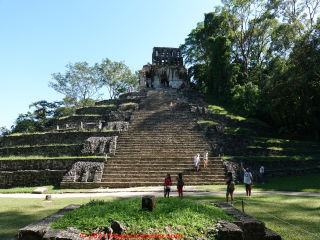
And while I've photographed and measured modern stairs and rails in Mexico, I'm still enchanted by the big pyramids. This view *down* steps from the Pyramid del sol (2011) show how daunting it can be, and even more difficult, to climb down such steep rise steps than to climb up them,

Finally, here's a photo of a tourist atop the Sun Pyramid, giving an idea of the scale of these structures.
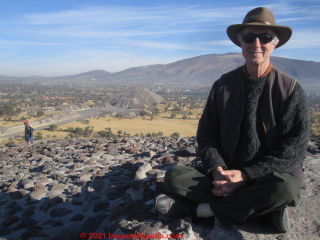
It seemed that the stair step height was taller in Algodones, MX than in the United States. Or is there no standard step height in Mexico?
 Floyd
Floyd
Thank you for that remarkable comment. If you have a photo of the stairs you're describing you can use the add image button to let us see that.
One photo per comment but as many comments as you need if you have more than one photo.
My OPINION
is that while stair construction is not particularly regulated in Mexico nor in quite a few other communities, at least for the curved treads we see on the Oxaca stairs, if the builder had included a pair of center handrails that'd reduce the tendency to step into the most-dangerous part of the steps.
One difference between the U.S. and Mexico's response to stair and other triop hazards is that in the U.S. we are habituated to expect the government to protect us from hazards and to expect or lawyer to get us some money if we fall down the stairs.
In Mexico people know that they might fall down the stairs and that nobody is likely to pay their medical bills for them, so they are, perhaps, a bit more-attentive and more-careful.
The Oxaca Concrete stairway is a one of a kind , Expensive Colored concrete Stairway , I set form*s and poured concrete on Hotels , Resorts , Even the test range in Nevada , All withen the western US states , A Commercial set of stairs like this , Done in ( US ) Would be broken into pieces , Loaded in a dump truck and hauled to the dump .
I don*t really understand why anyone with the skills it took to build these steps , Didn*t know any better . The Guy who poured the concrete made it look ok , And had to of known better , I do live in the Country with the highest standards though , And for that I thank my lucky stars .
When is it. Required to install a hand rail?
Four risers or steps, Randy, and as we calculate the riser height as 29 / 4 we get each step rise height as 7 1/4" tall. That keeps us close to the ideal or desired step height.
How many steps would you have to have for a 29 inch high porch
Sounds like a trip hazard, that's the first concern, and yes, quite possibly your local building code official will object
Steps for built all risers and treads for the same height contractor came in and put blue stone in and now the bottom step is a lot smaller for the riser is that okay will it pass inspection?
Im not a lawyer, but in my experience the building owner has responsibility for hazards at their own property
I've recently come across an issue where a concrete sidewalk was poured leading up to an exterior porch stair, and the height of the slab made the first step much lower than the rest (much like in your picture of Quinn above). In my understanding of the building code this is a trip hazard as it creates a very unequal riser and thus is not compliant.
My question is, who is responsible in terms of an accident or lawsuit. Obviously the original builder shouldn't be, if they built a compliant stair, so I'm thinking the person who built the sidewalk should be responsible for fixing it (even if stairs are not their area of expertise) as they created the problem.
Or does the homeowner become responsible for allowing it to happen and paying the sidewalk builder prior to realising it wasn't to code? If the sidewalk builder has a license can they be held accountable for their mistake?
See your question you posted at
https://inspectapedia.com/Stairs/Stair_Tread_Dimensions.php
What is the building code for building stairs from first floor to second floor in Maryland..
Yes, steps may be under 7 " high.
7 is a recommended riser height, not the only one allowed. Eg. 6.75 or 7.2 are allowed
Risers should, however, be uniform
Is there a step riser height less than 7 inches
Helena,
The article above you will see this standard
Step riser specifications riser height (<= 7.75" or in some codes <= 7.0" or in canada <=8.25") maximum and 4 inches (102 mm) minimum.
the concern is that if you make the step rise less than 4 in you're more likely creating a tow catching trip hazard.
for seniors or anyone who has difficulty climbing stairs it's very important to attend all of the safety features such as lighting, handrails, and where appropriate color keys showing the edges of steps
See ELDERLY & VETERANS HOME SAFETY
See ADA STAIR & RAIL SPECIFICATIONS
What is minimum stair riser height for outside stairs ( such as for making it easier for elderly people to climb)?
To meet building codes requirements.
That's an interesting question; you're basically extending the floor area by the width of a stair tread, right? Why would you do that? It pushes the whole stairway out by the depth of the stair tread in move that would be unnecessary - but then I can't see your situation, perhaps I'm missing something.
I don't think we'll find an explicit prohibition in the stair codes, since the code writers can't and don't try to anticipate every possible variation on what people may invent.
But a local building code inspector MIGHT interpret that top tread as a stair top platform.
If she does, then the stairs would be improper as the platform would be very much too short. A platform needs to run no less than 3 ft. in the direction of travel up and down the stairs, and yours would run what, maybe 11" - or whatever is your tread depth.
Can the top tread of a stair stringer be the same elevation as the finish floor ?
Stair Riser Height for Seniors & People with Limited Stair Climbing Ability
Reader Question: 28 April 2015 Cynthia Johnson said:
What are the best dimensions for seniors with physical limitations i.e. Rheumatoid Arthritis?
Reply:
Experts suggest that for more physically limited people the best way avoid falls is to seek living accomodations on a single floor.
Affi et als (2014 and earlier) have weighted the contributions of various stair features to the risk of a stair fall, considering for example, straight versus turned stairways, with or without landings, number of steps, handraiil design, lighting specifications, and step design specifications (using a tread depth of 269mm and a riser height of 174mm with a 40 mm tread nosing in a case example to state various risk contributors.
Please see complete details f step design for people with physical limitations at STAIR DESIGN for SENIORS
...
Continue reading at STAIR TREAD DIMENSIONS or select a topic from the closely-related articles below, or see the complete ARTICLE INDEX.
Or see STAIR RISER HEIGHT FAQs questions & answers posted originally on this page.
Or see these
Recommended Articles
- RAILING CODES & SPECIFICATIONS
- SLIP TRIP & FALL HAZARD LIST, STAIRS
- STAIR CODES & STANDARDS - free downloadable PDF files of building codes & standards
- STAIR RISE & RUN GEOMETRY & CALCULATIONS
- STAIR DIMENSIONS, WIDTH, HEIGHT
- STAIR ANGLE & SLOPE
- STAIR DESIGN for SENIORS
- STAIR DESIGNS for UNEVEN / SLOPED SURFACES
- STAIR CONSTRUCTION IDEAL DIMENSIONS
- STAIR CONSTRUCTION, LOW ANGLE SLOPE
- STAIR CONSTRUCTION, SPECIFIC ANGLE or SLOPE
- STAIR HEADROOM
- STAIR PLATFORMS & LANDINGS
- STAIR RISE & RUN CALCULATIONS
- STAIR RISER SPECIFICATIONS
- STAIR STRINGER SPECIFICATIONS
- STAIR STRINGER DEFECTS
- STAIR TREAD DIMENSIONS
- STAIR TREAD - HALTING WALK STUTTER STEP
- STAIR TREAD NOSE SPECIFICATIONS
- STAIR USER FOOT & HAND PLACEMENT
Suggested citation for this web page
STAIR RISER SPECIFICATIONS at InspectApedia.com - online encyclopedia of building & environmental inspection, testing, diagnosis, repair, & problem prevention advice.
Or see this
INDEX to RELATED ARTICLES: ARTICLE INDEX to STAIRS RAILINGS LANDINGS RAMPS
Or use the SEARCH BOX found below to Ask a Question or Search InspectApedia
...
Ask a Question or Search InspectApedia
Try the search box just below, or if you prefer, post a question or comment in the Comments box below and we will respond promptly.
Search the InspectApedia website
Note: appearance of your Comment below may be delayed: if your comment contains an image, web link, or text that looks to the software as if it might be a web link, your posting will appear after it has been approved by a moderator. Apologies for the delay.
Technical Reviewers & References
Click to Show or Hide Citations & References
Publisher InspectApedia.com - Daniel Friedman
Free Step by Step Drawings for Outdoor Deck
Source: https://inspectapedia.com/Stairs/Stair_Risers.php
Enviar um comentário for "Free Step by Step Drawings for Outdoor Deck"